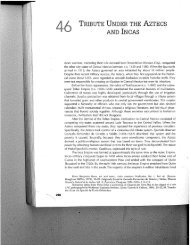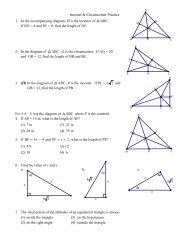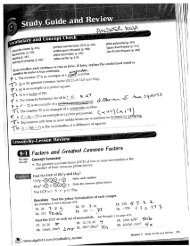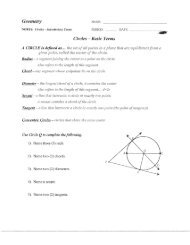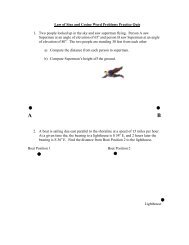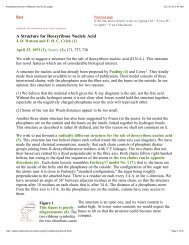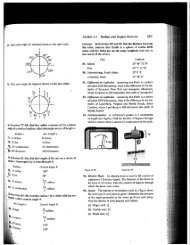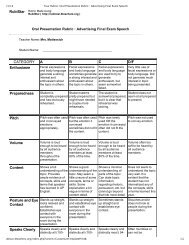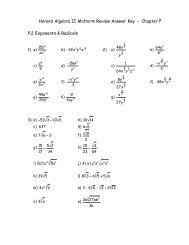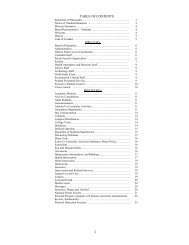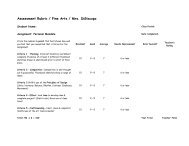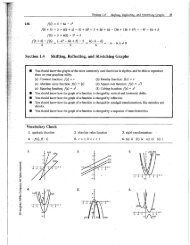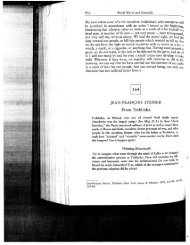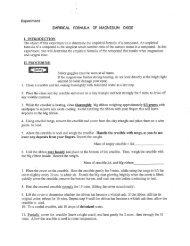Letter on Turkish Smallpox Inoculation
Letter on Turkish Smallpox Inoculation
Letter on Turkish Smallpox Inoculation
Create successful ePaper yourself
Turn your PDF publications into a flip-book with our unique Google optimized e-Paper software.
Scientific Revoluti<strong>on</strong><br />
eer, crossing boundaries of educati<strong>on</strong> and<br />
m insects and nurturing daughters as she<br />
~te. Her focus <strong>on</strong> breeding, habitat,<br />
ith the domestic practice of a<br />
fe. We have here not a female mind uneasy<br />
<strong>on</strong>nected to the organic (images that have<br />
t in recent scholarship), but a woman<br />
prise <strong>on</strong> a creative margin- for her<br />
.’n domestic workshop and learned<br />
it to Maria Sibylla Merian than her<br />
~e sanctificati<strong>on</strong> of her entomological<br />
is transformati<strong>on</strong>s," she wrote in her 167<br />
~appened so many times that <strong>on</strong>e is full<br />
power and his w<strong>on</strong>derful attenti<strong>on</strong><br />
m d unworthy flying things . . . Thus<br />
acles such as these to the world in a<br />
:h<strong>on</strong>or me for it; praise God al<strong>on</strong>e<br />
smallest and most insignificant<br />
her c<strong>on</strong>versi<strong>on</strong><br />
but her stress <strong>on</strong> God’<br />
talking about insects<br />
prophetic and lyrical<br />
de Labadie had said<br />
announces God or<br />
the voice of a<br />
the sea and its<br />
tells of God<br />
try to hear or see<br />
LADY MARY WORTLEY MONTAGUE<br />
<str<strong>on</strong>g>Letter</str<strong>on</strong>g> <strong>on</strong> <strong>Turkish</strong> <strong>Smallpox</strong> Inoculati<strong>on</strong><br />
Lady Mary Wortley M<strong>on</strong>tague, an English aristocrat, came down<br />
with smallpox in 1715. She survived, but was badly scarred by the<br />
rash that accompanied the often-fatal disease. Her younger brother<br />
died from smallpox, <strong>on</strong>e of the tens of thousands who succumbed in<br />
epidemics across Europe and around the world in the eighteenth and<br />
nineteenth centuries. Two years after her recovery M<strong>on</strong>tague traveled<br />
to Istanbul with her husband, who was the British ambassador to the<br />
Ottoman Empire. There, she witnessed a new approach to w, arding<br />
off smallpox infecti<strong>on</strong>s, as she described in the following letter to a<br />
friend in England. What process does M<strong>on</strong>tague describe in her letter<br />
What was her resp<strong>on</strong>se to the events she witnessed in Turkey<br />
Thinking Historically<br />
This letter provides a clear example of how scientific observati<strong>on</strong> can<br />
change the material world in which we live. After observing the <strong>Turkish</strong><br />
smallpox inoculati<strong>on</strong> M<strong>on</strong>tague had her s<strong>on</strong> and daughter inoculated.<br />
In fact, she became an advocate for smallpox inoculati<strong>on</strong> in<br />
England and played an important role in persuading the English medical<br />
professi<strong>on</strong> to support the innovative procedure. M<strong>on</strong>tague paved<br />
the way for a safer vaccine, developed by Edward Jenner iu 1796, that<br />
would eventually eradicate the disease from the planet.<br />
Despite her admirable efforts, it was difficult to c<strong>on</strong>vince Europeans<br />
to embrace smallpox inoculati<strong>on</strong>, which had been practiced in<br />
Asia for centuries. Even though the effectiveness of this techuology.<br />
came to be recognized in England during M<strong>on</strong>tague’s lifetime, the<br />
French and other Europeans, accordiug to Voltaire, thought that the<br />
English were "fools and madmen" for experimenting with inoculati<strong>on</strong>.<br />
What does this suggest about the nature of scientific discovery<br />
Besides lack of knowledge, what Other obstacles need to be overcome<br />
of Lady Mary Wortley M<strong>on</strong>tague, written during her travels in Europe, Asia, and<br />
to which are added poems by the same author (Bordeaux J. Pinard 180.5). Tbe UCL A<br />
M. Darling Biomedical Library, History a~ld Special Collecti<strong>on</strong>s Divisi<strong>on</strong>.<br />
715
The Scientific Revoluti<strong>on</strong><br />
To Mrs. S. C., Adrianople, April 1, O.S.<br />
APropos of distempers, I am going to tell you a thing, that will<br />
you wish yourself here. The small pox, so fatal, and so general amo<br />
us, is here entirely harmless, by the inventi<strong>on</strong> of ingrafting, which<br />
term they give it. There is a set of old ,vomen, who make it their busin<br />
to perform the operati<strong>on</strong>, every autumn, in the m<strong>on</strong>th of septemb<br />
when the great heat is abated. People send to <strong>on</strong>e another to know if<br />
of their family has a mind to have the small-pox; they make parties<br />
this purpose, and when they are met (comm<strong>on</strong>ly fifteen or sixteen<br />
gether) the old woman comes with a nut-~hell full of the matter of<br />
best sort of small pox, and asks what vein you please to opened,<br />
She immediately rips open than you offer to her, with a<br />
(which gives youno more pain than a comm<strong>on</strong> scratch), and puts i<br />
the vein as much matter as can lie up<strong>on</strong> the head of her needle,<br />
that, binds up the little wound with a hollow bit of shell, and in<br />
manner opens four or five veins. The Grecians have comm<strong>on</strong>l<br />
stiti<strong>on</strong> of opening <strong>on</strong>e in the middle of the forehead, <strong>on</strong>e in each<br />
and <strong>on</strong>e in the breast, to mark the sign of the cross; but this has a<br />
effect, all these wounds leaving little scars, and is not d<strong>on</strong>e by<br />
are not superstitious, who choose to have them in the legs, or that<br />
the arm that is c<strong>on</strong>cealed. The children or young patients play<br />
all the rest of the day, and are in perfect health to the eighth.<br />
Then the fever begins to seize them, and they keep their beds<br />
days, very seldom three. They have very rarely above twenty or<br />
in their faces, which never mark, and in eight days time they are<br />
as before their illness. Where they<br />
sores during the distemper, which I d<strong>on</strong>’t doubt is a great<br />
Every year thousands undergo this operati<strong>on</strong>, and the<br />
sador says pleasantly that they take the small-pox here by way of d<br />
si<strong>on</strong>, as they take the *vaters in other countries. There "<br />
any <strong>on</strong>e that has died in it, and you may believe I am well<br />
the safety of this experiment, since I intend to try it <strong>on</strong> my<br />
s<strong>on</strong>. I am patriot enough to take pains to bring this useful<br />
into fashi<strong>on</strong> in England, and I should not fail to<br />
doctors very particularly about it, if I knew any <strong>on</strong>e<br />
thought had virtue enough to destroy such a c<strong>on</strong>siderable<br />
their revenue, for the good of mankind. But that distemper is todi<br />
ficial to them, not to expose to all their resentment<br />
that should undertake to put an end to it. Perhaps if Ili<br />
may, however have the courage to war with them. Up<strong>on</strong> this c<br />
admire the heroism in the heart of<br />
Your friend, etc. etc.<br />
~Creature,
SUGITA GEMPAKU<br />
A Dutch Anatomy Less<strong>on</strong> in Japan<br />
Sugita Gempaku* (1733-1817) was a Japanese physician who, as he<br />
tells us here in his memoir, suddenly di~coyered the value of Western<br />
medical science when he chanced to wime~s a dissecti<strong>on</strong> shortly after<br />
he obtained a Dutch anatomy book.<br />
What ~vas it that Sugita Gempaku learned <strong>on</strong> that day in 17717<br />
What were the differences between the treatments of anatomy in the<br />
Chinese Book of Medicine and the Dutch medical book What accounts<br />
for these differences <br />
Thinking Historically<br />
How might the Dutch book have changed the way the author practiced<br />
medicine How did it change his knowledge of the humar<br />
How did it change the relevance of his knowledge of the human<br />
to the medicine he practiced How revoluti<strong>on</strong>ary was the new knowledge<br />
for Sugita Gempaku<br />
Whenever I met Hiraga Gennai (1729-1779), we talked<br />
<strong>on</strong> this matter: "As we have learned, the Dutch method<br />
vestigati<strong>on</strong> through field work and surveys is truly amazing.<br />
directly understand books written by them, we will .benefit<br />
However, it is pitiful that there has been no <strong>on</strong>e who has set<br />
<strong>on</strong> working in this field. Can we somehow blaze this trail<br />
sible to do it in Edo. Perhaps it is best if we<br />
gasaki to make some translati<strong>on</strong>s. If<br />
lated, there will be an immeasurable benefit to the<br />
time we spoke in this manner, we deplored the "<br />
*SO0 gee tab gehm PAH koo<br />
Sugita Gempaku, Ranto Kotohajime (The Beginning of Dutch S<br />
Lu, ed., Japan: A Documentary History, vol. I (Arm<strong>on</strong>k, N.Y.: M.<br />
Iwanami Shoten, Nih<strong>on</strong> Koten Bunka Taikei (M~<br />
95 (Tokyo: Iwanami Shoten, 1969), 48%93.<br />
722
Gempaku / A Dutch Anatomy Less<strong>on</strong> in Japan 723<br />
in Japan<br />
physician who, as he<br />
[ the value of Western<br />
dissecti<strong>on</strong> shortly after<br />
that day in 1771<br />
of anatomy in the<br />
book What ac-<br />
.way the author pracof<br />
the human body<br />
the human body<br />
the new knowl-<br />
~ each other<br />
f scholarly inamazing<br />
If we can<br />
1 benefit greatly.<br />
, has set his mind<br />
menting our desires. However, we did not vainly lament the matter for<br />
l<strong>on</strong>g.<br />
Somehow, miraculously I obtained a book <strong>on</strong> anatomy written in<br />
that country. It may well be that Dutch studies in this country began<br />
when I thought of comparing the illustrati<strong>on</strong>s in the book with real<br />
things. It was a strange and even miraculous happening that I was able<br />
to obtain that book in that particular spring of 1771. Then at the night<br />
of the third day of the third m<strong>on</strong>th, I received a letter from a man by<br />
the name of Tokuno Bambei, who ~vas in the service of the then Town ......<br />
Commissi<strong>on</strong>er, Magaribuchi Kai-no-kami. Tokuno st~te.d in his letter ’<br />
that "A post-mortem examinati<strong>on</strong> of the body of a c<strong>on</strong>demned criminal<br />
by a resident physician will be held tomorrow at Senjukotsukahara.<br />
You are welcome to witness it if you so desire." At <strong>on</strong>e time my colleague<br />
by the name of Kosugi Genteki had an occasi<strong>on</strong> to witness<br />
a post-mortem dissecti<strong>on</strong> of a body when he studied under Dr.<br />
Yamawaki T6y6 of Kyoto. After seeing the dissecti<strong>on</strong> firsthand, Kosugi<br />
remarked that what was said by the people of old was false and simply<br />
could not be trusted. "The people of old spoke of nine internal organs,<br />
and nowadays, people divide them into five viscera and six internal organs.<br />
That [perpetuates] inaccuracy," Kosugi <strong>on</strong>ce said. Around that<br />
time (1759) Dr. T6y6 published a book entitled Zfshi (On Internal<br />
Organs). Having read that book, I had hoped that some day I could<br />
witness a dissecti<strong>on</strong>. When I also acquired a Dutch book <strong>on</strong> anatomy, I<br />
wanted above all to compare the two to find out which <strong>on</strong>e accurately<br />
described the truth. I rejoiced at this unusually fortunate circumstance,<br />
and my mind could not entertain any other thought. Ho~vever, a<br />
thought occurred to me that I should not m<strong>on</strong>opolize this good fortune,<br />
and decided to share it with those of my colleagues who were diligent<br />
pursuit of their medicine ...Ȧm<strong>on</strong>g those I invited was <strong>on</strong>e<br />
[Maeno] Ry6taku (1723-1803)..<br />
The next day, when we arrived at the locati<strong>on</strong>... Ry6taku reache~l<br />
under his kim<strong>on</strong>o to produce a Dutch book and showed it to us. "This<br />
is a Dutch book of anatomy called Tabulae Anatomicae. I bought this a<br />
ago when I went to Nagasaki, and kept it." As I examined it,<br />
book I had and was of the same editi<strong>on</strong>. We held each<br />
hands and exclaimed: "What a coincidence!" Ry6taku c<strong>on</strong>tinby<br />
saying: "When I went to Nagasaki, I learned and heard," and<br />
book. "These are called l<strong>on</strong>g in Dutch, they are lungs," he<br />
us. "This is hart, or the heart. When it says maag it is the stomand<br />
when it says milt it is the spleen." However, they did not look<br />
the heart given in the Chinese medical books, and n<strong>on</strong>e of us were<br />
could actually see the dissecti<strong>on</strong>.<br />
Thereafter we went together to the place which was especially set for<br />
observe the dissecti<strong>on</strong> in Kotsukahara .... The regular man who<br />
the chore of dissecti<strong>on</strong> was ill, and his grandfather, who was
724 The Scientific Revoluti<strong>on</strong><br />
ninety years of age, came in his place. He was a healthy old man. He h<br />
experienced many dissecti<strong>on</strong>s since his youth, and boasted that he di<br />
sected a number of bodies. Those dissecti<strong>on</strong>s were performed in thos<br />
days by men of the eta ~ class .... That day, the old butcher pointed t<br />
this and that organ. After the heart, liver, gall bladder, and stomach we<br />
identified, he pointed to other parts for which there were no names.<br />
d<strong>on</strong>’t know their names. But I have dissected quite a few bodies from m<br />
youthful days. Inside of every<strong>on</strong>e’s abdomen there were these parts an<br />
those parts." Later, after c<strong>on</strong>sulting the anatomy chart, it became clea r<br />
me that I saw an arterial tube, a vein, and the suprarenal giandl The ol<br />
butcher again said, "Every time I had a dissecti<strong>on</strong>, I pointed out to thos<br />
physicians many of these parts, but not a single <strong>on</strong>e of them questi<strong>on</strong>e<br />
’what was this’ or ’what was that’" We compared the body as dis<br />
sected against the charts both Ry~)taku and I had, and could not find<br />
single variance from the charts. The Chinese Book<br />
says that the lungs are like the eight petals of the lotus flower,<br />
petals hanging in fr<strong>on</strong>t, three in back, and two petals forming like tw<br />
ears and that the liver has three petals to the left and four petals to th<br />
right. There were no such divisi<strong>on</strong>s, and the positi<strong>on</strong>s and shapes<br />
testines and gastric organs were all different from those taught by<br />
theories. The official physicians, Dr. Okada Y6sen and Dr.<br />
Rissen, have witnessed dissecti<strong>on</strong> seven or eight times. Whenever the<br />
witnessed the dissecti<strong>on</strong>, they found that the old theories c<strong>on</strong>tradicted r,<br />
ality. Each time they were perplexed and could not resolve their doubt<br />
Every time they wrote do*vn what they thought was strange.<br />
in their books. "The more we think of it, there must be<br />
ferences in the bodies of Chinese and of the eastern barbarians [iiei<br />
Japanese]." I could see why they wrote this way.<br />
That day, after the dissecti<strong>on</strong> was over, we decided that wei<br />
should examine the shape of the skelet<strong>on</strong>s left exposed <strong>on</strong> th~<br />
ground. We collected the b<strong>on</strong>es, and examined a number of<br />
Again, we were struck by the fact that they all differed from<br />
theories while c<strong>on</strong>forming to the Dutch charts.<br />
The three of us, Ry6taku, [Nakagawa] Junan (1739-1786<br />
went home together. On the way home we spoke<br />
the same way. "How marvelous was our actual experience today!<br />
shame that we were ignorant of these things unti! now. As<br />
who serve their masters through medicine, we<br />
complete ignorance of the true form of the human body.<br />
ful it is. Somehow, through this experience,<br />
truth about the human body. if we<br />
edge behind us, we can make c<strong>on</strong>tributi<strong>on</strong>s for people<br />
XThe eta were an untouchable caste in Japan, defined by<br />
pati<strong>on</strong>s associated with death -- tanning or ~vorking with hides, cremating<br />
ing meat, and, thus, doing autopsies. They could not be physicians. [Ed.]
entitle Revoluti<strong>on</strong><br />
place. He was a healthy old man. He had<br />
ii~ce his youth, and boasted that he dis~<br />
~0~e dissecti<strong>on</strong>s were performed in those<br />
i That day, the okt butcher pointed to<br />
~r~; liver, gall bladder, and stomach were<br />
parts for which there were no na s. I<br />
i~e dissected quite a few bodies from my<br />
~’~ abdomen there were these parts and<br />
e anatomy chart, it became clear to<br />
and the suprarenal gland. The ol,<br />
a dissecti<strong>on</strong>, I pointed out to those<br />
<strong>on</strong>e of them q~<br />
We compared the body as<br />
and I had, and could not find<br />
Book of Medicine (Yi<br />
; of the lotus flower, with three<br />
and two petals forming like two<br />
the left<br />
¯<br />
and four petals<br />
’ and shapes<br />
from those taught by<br />
Y6sen and Dr.<br />
or eight times.<br />
old theories<br />
:l no<br />
was strang<br />
be fundamenta!<br />
f the eastern barbarians<br />
Franklin / <str<strong>on</strong>g>Letter</str<strong>on</strong>g> <strong>on</strong> a Ballo<strong>on</strong> Experiment in 1783 725<br />
and <strong>on</strong> this earth." Ry6taku spoke to us. "Indeed, I agree with you<br />
wholeheartedly." Then I spoke to my two compani<strong>on</strong>s. "Somehow if<br />
we can translate anew this book called Tabulae Anatomicae, we can get<br />
a clear noti<strong>on</strong> of the human body inside out. It will have great benefit<br />
in the treatment of our patients. Let us do our best to read it and understand<br />
it without the help of translators." Ry6taku resp<strong>on</strong>ded: "I have<br />
been wanting to read Dutch books for some time, but there has been no<br />
friend who would share my ambiti<strong>on</strong>s. I have spent days lamenting it.<br />
If both of you wish, I have been in Nagasaki before and have retained<br />
some Dutch. Let us use it as a beginning to tackle the. book together."<br />
After hearing it, I ans~vered, "This is simply w<strong>on</strong>derful. If we are to<br />
join our efforts, I shall also resolve to do my very best."...<br />
The next day, we assembled at the house of Ry6taku and recalled<br />
the happenings of the previous day. When we faced that Tabulae<br />
Anatomicae, we felt as if we were setting sail <strong>on</strong> a great ocean in a ship<br />
without oars or a rudder. With the magnitude of the work before us,<br />
we were dumbfounded by our own ignorance. However, Ry6taku had<br />
been thinking of this for some time, and he had been in Nagasaki. He<br />
knew some Dutch through studying and hearing, and knew some sentence<br />
patterns and words. He was also ten years older than I, and we<br />
decided to make him head of our group and our teacher. At that time I<br />
did not kno~v the twenty-five letters of the Dutch alphabet. I decided to<br />
study the language with firm determinati<strong>on</strong>, but I had to acquaint myself<br />
with letters and words gradually.<br />
we decided that we<br />
a number of<br />
all differed from<br />
unan (1739-1786<br />
) each other and<br />
y. Iti=<br />
As<br />
our<br />
bod}<br />
people under<br />
BENJAMIN FRANKLIN<br />
<str<strong>on</strong>g>Letter</str<strong>on</strong>g> <strong>on</strong> a Bal!o<strong>on</strong> Experiment in 1783<br />
Benjamin Franklin (1706-1790) was the preeminent statesman, diplomat,<br />
and spokesman for the British col<strong>on</strong>ies that became the United<br />
States during his l<strong>on</strong>g lifetime. Trained as a candle maker and printer,<br />
he became a journalist, publisher, merchant, homespun philosopher,<br />
and inveterate inventor. He invented the lightning rod, the Franklin<br />
stove, bifocals, and the medical catheter, am<strong>on</strong>g other things. His<br />
*, ed., The Ingenious Dr. Franklin, Selected Scientific <str<strong>on</strong>g>Letter</str<strong>on</strong>g>s of Benjamin<br />
ia: University of Pennsylvania Press, 1931), 99-102.
The Scientific Revoluti<strong>on</strong><br />
inventi<strong>on</strong>s sprang from a gift of immense curiosity and an exhaustive<br />
reading in the science of his day.<br />
Franklin, sometimes called "the first American," represented the<br />
fledging Republic in France during the Revoluti<strong>on</strong>, ensuring French<br />
participati<strong>on</strong> against the British. In 1783 he signed the sec<strong>on</strong>d Treaty<br />
of Paris, by which the British recognized the independence of the<br />
United States. Franklin was the <strong>on</strong>ly founding father to sign the Declarati<strong>on</strong><br />
of Independence (1776), the Treaty of Paris (1783), and the<br />
C<strong>on</strong>stituti<strong>on</strong> of the United States (1789). Throughout his life Franklin<br />
furthered his interest in scientific experiment and inventi<strong>on</strong>. In December<br />
of 1783, he wrote to a friend about h recent inventi<strong>on</strong> that fascinated<br />
him: an early experiment in air travel in a ballo<strong>on</strong>. What did<br />
Franklin see and what did it mean to him<br />
Thinking Historically<br />
What evidence do you see in this letter that the scientific revoluti<strong>on</strong><br />
was a genuinely revoluti<strong>on</strong>ary change What was revoluti<strong>on</strong>ary about<br />
it What evidence do you see that the people of the time thought they<br />
were living in a revoluti<strong>on</strong>ary age How would you compare their attirades<br />
with those of people today toward modern technological iuno~<br />
vati<strong>on</strong>8<br />
TO<br />
SIR JOSEPH BANKS<br />
Dear Sir: --<br />
In mine of yesterday I promised to give you an account<br />
Charles & Robert’s experiment, which was to have<br />
and at which I intended to be present. Being a little indisposed,<br />
air cool, and the ground damp, I declined going into the<br />
Tuileries, where the ballo<strong>on</strong> was placed, not knowing how l<strong>on</strong>g<br />
be obliged to wait there before it was ready to depart,<br />
in my carriage near the statue of Louis XV, from whence<br />
see it rise, and have an extensive view of the regi<strong>on</strong> of<br />
which, as the wind sat, it was likely to pass. The morning<br />
but about <strong>on</strong>e o’clock the air became tolerably clear, to<br />
facti<strong>on</strong> of the spectators, who were infinite,<br />
the intended experiment several days before in the<br />
Paris was out, either about the Tuileries, <strong>on</strong> the quays<br />
the fields, the streets, at the windows, or <strong>on</strong> the tops<br />
the inhabitants of all the to~vns and villages of the<br />
fore was a philosophical experiment so
mtific Revoluti<strong>on</strong><br />
of immense curiosity and an exhaustive<br />
~y.<br />
"the first American," represented the<br />
luring the Revoluti<strong>on</strong>, ensuring French<br />
iK In 1783 he signed the sec<strong>on</strong>d Treaty<br />
~h recognized the independence of the<br />
i~ 0nly founding father to sign the Decfi);<br />
the Treaty of Paris (1783), and the<br />
~ (1789). Throughout his life Franklin<br />
C experiment and inventi<strong>on</strong>. In Decem-<br />
I about a recent inventi<strong>on</strong> that fascitravel<br />
in a ballo<strong>on</strong>. What did<br />
him<br />
that the scientific revoluti<strong>on</strong><br />
What was revoluti<strong>on</strong>ary about<br />
they<br />
you compare their atmodern<br />
technological inno-<br />
Passy, Dec. 1,<br />
account of<br />
this day~<br />
indisposed,<br />
into the garden<br />
:how l<strong>on</strong>g I<br />
and<br />
of air<br />
was<br />
great<br />
ever<br />
Franklin / <str<strong>on</strong>g>Letter</str<strong>on</strong>g> <strong>on</strong> a Ballo<strong>on</strong> Experiment in 1783 727<br />
guns were fired to give notice that the departure of the ballo<strong>on</strong> was<br />
near, and a small <strong>on</strong>e was discharged, which went to an amazing<br />
height, there being but little wind to make it deviate from its perpendicular<br />
course, and at length the sight of it was lost. Means were used, I<br />
am told, to prevent the great ballo<strong>on</strong>’s rising so high as might endanger<br />
its bursting. Several bags of sand were taken <strong>on</strong> board before the cord<br />
that held it down was cut, and the whole weight being then too much<br />
to be lifted, such a quantity was discharged as to permit its rising<br />
slowly. Thus it would so<strong>on</strong>er arrive at that regi<strong>on</strong> where it would be in<br />
equilibrio with the surrounding air, and by dischargi.ng more sand afterwards,<br />
it might go higher if desired. Between <strong>on</strong>e and two o’clock,<br />
all eyes were gratified with seeing it rise majestically from am<strong>on</strong>g the<br />
trees, and ascend gradually above the buildings, a most beautiful spectacle.<br />
When it was about two hundred feet high, the brave adventurers<br />
held out and waved a little white pennant, <strong>on</strong> both sides [of] their car,<br />
to salute the spectators, who returned loud claps of applause. The wind<br />
was very little, so that the object though moving to the northward, c<strong>on</strong>tinued<br />
l<strong>on</strong>g in view; and it was a great while before the admiring people<br />
began to disperse. The pers<strong>on</strong>s embarked were Mr. Charles, professor<br />
of experimental philosophy, and a zealous promoter of that science;<br />
and <strong>on</strong>e of the Messieurs Robert, the very ingenious c<strong>on</strong>structors of the<br />
machine. When it arrived at its height, which I suppose might be three<br />
or four hundred toises, it appeared to have <strong>on</strong>ly horiz<strong>on</strong>tal moti<strong>on</strong>. I<br />
had a pocket-glass, with which I followed it, till I lost sight first of the<br />
men, then of the car, and when I last saw the ballo<strong>on</strong>, it appeared no<br />
bigger than a walnut. I write this at seven in the evening. What became<br />
of them is not yet known here. I hope they descended by daylight, so as<br />
to see and avoid falling am<strong>on</strong>g trees or <strong>on</strong> houses, and that the experiment<br />
was completed without any mischievous accident, which the novelty<br />
of it and the want of experience might well occasi<strong>on</strong>. I am the more<br />
anxious for the event, because I am not well informed of the rrfeans<br />
provided for letting themselves down, and the loss of these very ingenious<br />
men would not <strong>on</strong>ly be a discouragement to the progress of the<br />
art, but be a sensible loss to science and society.<br />
I shal! inclose <strong>on</strong>e of the tickets of admissi<strong>on</strong>, <strong>on</strong> which the globe<br />
represented, as originally intended, but is altered by the pen to<br />
show its real state when it went off. When the tickets were engraved the<br />
was to have been hung to the neck of the globe, as represented by a<br />
little drawing I have made in the corner.<br />
I suppose it may have been an apprehensi<strong>on</strong> of danger in straining<br />
: the silk, that induced the c<strong>on</strong>structors<br />
throw a net over it, fixed to a hoop which went round its middle,<br />
and to hang the car to that hoop.<br />
Tuesday morning, December 2d.- I am relieved from my anxiety<br />
that the adventurers descended well near L’Isle Adam before
728 The Scientific Revoluti<strong>on</strong><br />
sunset. This place is near seven leagues from Paris. Had the wind blow<br />
fresh they might have g<strong>on</strong>e much farther.<br />
If I receive any further particulars of importance, I shall commun<br />
cate them hereafter.<br />
With great esteem, I am, dear sir, your most obedient and most<br />
humble servant,<br />
FRANKLIN<br />
P.S. Tuesday evening. -- Since writing the above I have received the<br />
printed paper and the manuscript c<strong>on</strong>taining some particulars of th<br />
experiment, which I enclose. I hear further:that the travellers had pe<br />
fect command of their carriage, descending as they pleased by lettin<br />
some of the inflammable air escape, and rising again by dischargi<br />
some sand; that they descended over a field so low as to talk with th<br />
labourers in passing, and mounted again to pass a hill. The little ba<br />
lo<strong>on</strong> falling at Vincennes shows that mounting higher it met with a c<br />
rent of air in a c<strong>on</strong>trary directi<strong>on</strong>, an observati<strong>on</strong> that may be of use t<br />
future aerial voyagers.<br />
REFLECTIONS<br />
Was there a scientific revoluti<strong>on</strong> in the seventeenth and eighteenth<br />
tury By most measures we would have to say "yes." There were new<br />
polished-glass instruments with which to observe and measure; book<br />
theories, diagrams, debates, and discoveries emerged at a dizzying<br />
Age-old authorities- Aristotle, Ptolemy, even the Bible- were<br />
into questi<strong>on</strong>. The wisdom of the ages was interrogated for<br />
and forced to submit to tests by experiment. But these<br />
not have c<strong>on</strong>stituted a revoluti<strong>on</strong> if they occurred in a vacuum.<br />
Maria Sibylla Merian’s metaphor is perhaps most<br />
There was a metamorphosis--a change from <strong>on</strong>e way of lookin<br />
the world to another. We might even say it was a change<br />
dieval manner of wearing the world like a robe to a modern<br />
world as a stage, as a reality seen through a window, somethin<br />
rate that could be touched, weighed, measured, even bought<br />
However we choose to characterize the changes in<br />
ing during this period, it is important to emphasize the r<br />
impact of the European scientific revoluti<strong>on</strong> of the<br />
without slighting the scientific and technological achievements<br />
civilizati<strong>on</strong>s. Many of the scientific developments in Euro<br />
from foreign innovati<strong>on</strong>s, and in some fields Europe was<br />
vanced as other societies. Yet the scientific<br />
nati<strong>on</strong> of observati<strong>on</strong> and generalizati<strong>on</strong>
ientific Revoluti<strong>on</strong><br />
~ leagues from Paris. Had the ~vind blowr<br />
tch farther.<br />
ticulars of importance,<br />
dear sir, your most obedient and mos<br />
FRANKLIN<br />
the above I have received thl<br />
some particulars of<br />
the travellers had<br />
as they pleased by<br />
and rising again by discharging<br />
low as to talk with<br />
pass a hill. The little<br />
g higher it met with a curmay<br />
be of use<br />
eighteenth<br />
"yes." There were new<br />
bserve and measure; books<br />
at a dizzying<br />
Bible--were<br />
changes<br />
vacuum.<br />
of looking<br />
Reflecti<strong>on</strong>s 729<br />
matics, inducti<strong>on</strong> and deducti<strong>on</strong> established a body of knowledge and a<br />
method for research that proved lasting and irreversible.<br />
Why was it that China, so scientifically and technologically adept<br />
during the Sung dynasty, pictured hearts and lungs as flower petals in<br />
the late-MinE and early-Ch’ing seventeenth century Was it that Chinese<br />
science lost momentum or changed directi<strong>on</strong> Or does such a<br />
questi<strong>on</strong>, as Lynda Shaffer *varns, judge China unfairly by Western<br />
standards Do the peta! hearts reflect a different set of interests rather<br />
than a failure of Chinese science<br />
Chinese scientists excelled in acupuncture, mass.age, and herbal<br />
medicine, while European scientists excelled in surgery. It turned out<br />
that the inner workings of the human body were better revealed in surgical<br />
dissecti<strong>on</strong> than in muscle manipulati<strong>on</strong> or in oral remedies. And,<br />
as Sugita Gempaku reminds us, the Europeans not <strong>on</strong>ly cut and<br />
moved, they also named *vhat they found and tried to understand how<br />
it worked. Perhaps the major difference between science in Europe and<br />
that in India, China, and Japan in the seventeenth century was <strong>on</strong>e of<br />
perspective: Europeans were beginning to imagine the human body as a<br />
machine and asking how it worked. In some respects, the metaphor of<br />
man as a machine proved more fruitful than organic metaphors of humans<br />
as plants or animals.<br />
Asking probing questi<strong>on</strong>s and testing the answers also changed our<br />
understanding of the heavens. If mathematical calculati<strong>on</strong>s indicated<br />
that a star would appear at a particular spot in the heavens and it did<br />
not, Galileo might just as so<strong>on</strong> have questi<strong>on</strong>ed the observati<strong>on</strong> as the<br />
math. From the seventeenth century <strong>on</strong>, scientists would check <strong>on</strong>e or<br />
the other <strong>on</strong> the assumpti<strong>on</strong> that observati<strong>on</strong> and mathematics could be<br />
brought together to understand the same event, that they would have to<br />
be in agreement, and that such agreement could lead to laws that could<br />
then be tested and proved or disproved.<br />
It is this method of inquiry, not the discoveries, that was new. For<br />
the scientific method that emerged during this period c<strong>on</strong>stituted a systematic<br />
means of inquiry based <strong>on</strong> agreed-up<strong>on</strong> rules of hypothesis, experimentati<strong>on</strong>,<br />
theory testing, !aw, and disseminati<strong>on</strong>. This scientific inquiry<br />
*vas a social process in two important ways: First, any scientific<br />
discovery had to be reproducible and recognized by other scientists to<br />
gain credence. Sec<strong>on</strong>d, a community of scientists was needed to questi<strong>on</strong>,<br />
dismiss, or validate the work of its members.<br />
Finally, we return to Baumer’s emphasis <strong>on</strong> the societies of<br />
seventeenth-century science. The numerous organizati<strong>on</strong>s in Europe are<br />
testaments not <strong>on</strong>ly to a growing interest in science but to a c<strong>on</strong>tinuing<br />
public c<strong>on</strong>versati<strong>on</strong>. Science in Europe thus became a matter of public<br />
c<strong>on</strong>cern, a popular endeavor. Compare the masses of Parisians Ben<br />
Franklin described who turned out to view the ballo<strong>on</strong> experiment
The Scientific Revoluti<strong>on</strong><br />
with the few physicians gathered around Sugita Gempaku who co<br />
learn from the expertise of outcast butchers.<br />
Ultimately, then, the difference between European science and<br />
of India or China in the seventeenth century may have had more t<br />
with society than with culture. The development of modern<br />
methods relied <strong>on</strong> the numerous debates and discussi<strong>on</strong>s of a<br />
c<strong>on</strong>scious class of gentlemen scientists in a Europe where news<br />
quickly and ideas could be translated and tested with c<strong>on</strong>fidence acrc<br />
numerous borders. To what extent does science<br />
dem<strong>on</strong>strate the hallmarks of the seventeenth-century scientific<br />
ti<strong>on</strong>



